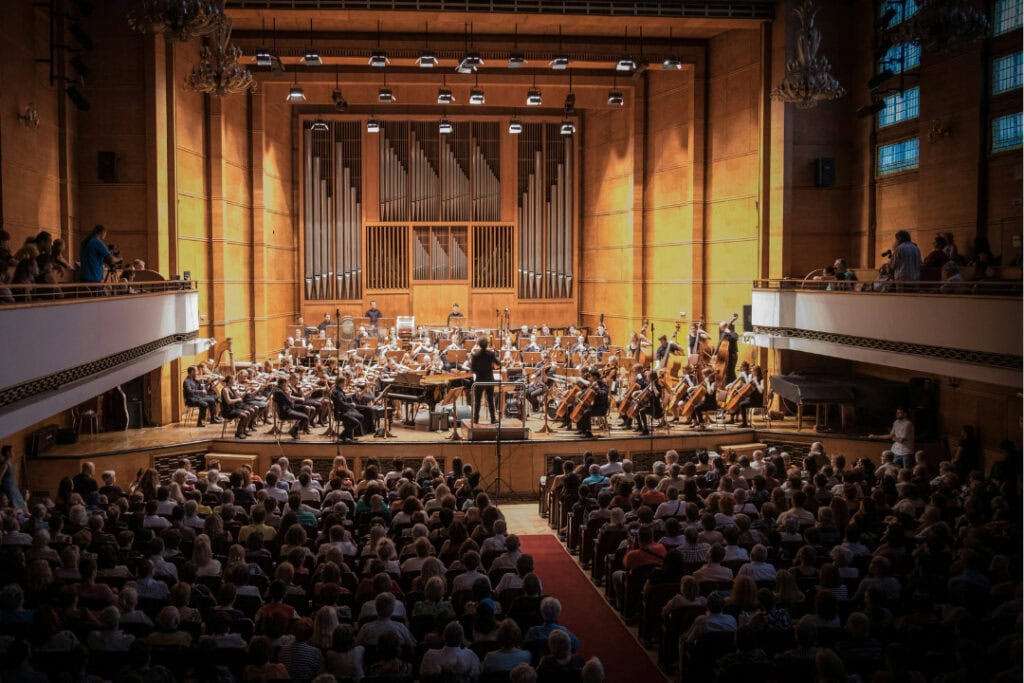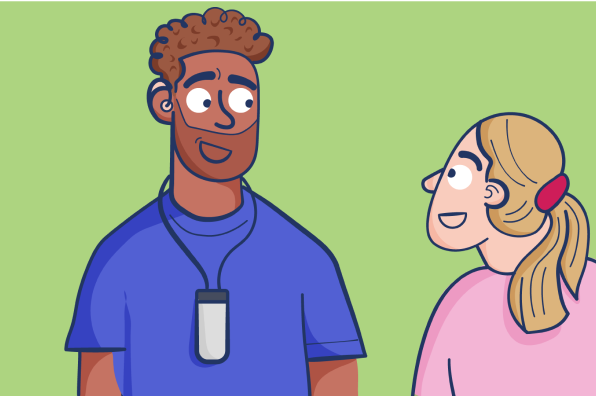
RNID’s Technology Lead, Alastair Moore, explains how you can use the telecoil-equipped hearing device you already own to access Auracast: an improved listening experience that is already available in forward-thinking public venues. The process is simple, but you need to be prepared.
In this article we’ll explain what Auracast is and why it is the future of assistive listening in public venues. We’ll also share how the Auracast signal can be picked up by a receiver device, which the venue will lend you, and what you need to do to ensure the signal can be passed on to your hearing devices.
The key is to make sure your devices have a telecoil programme (also known as a ‘T-setting’). If they don’t, you’ll need to contact your audiologist. Read on to find out more.
What is Auracast?
Auracast is a technology which allows high quality audio to be broadcast wirelessly by one device and picked up by many other devices, without having to go through a pairing process. It can be used in several ways, but is especially relevant to public venues, like theatres, lecture rooms, cinemas and places of worship.
In these venues, loudspeakers are used to emit the ‘clean’ original signal so that it is loud enough for the audience to hear. However, the listener will also hear reverberation, caused by the sound reflecting off walls and hard surfaces, and there could also be background noise. Together, reverberation and background noise can make it difficult to understand speech. This is especially true for people with hearing loss.
When a venue installs an Auracast transmitter the same signal which is emitted by the loudspeakers can also be broadcast as a wireless digital audio stream. This clean signal is picked up directly by an Auracast receiver, meaning the listener gets high quality audio, without any reverberation or noise.
Auracast receivers can come in all shapes and sizes, including earbuds, headphones and hearing aids. However, Auracast technology is very new, so very few people with hearing loss currently have devices with an Auracast receiver built in. Nevertheless, there is a way to benefit from Auracast using legacy technology.
Using an Auracast neckloop receiver
Venues which install an Auracast transmitter may be able to lend you a small device which is worn like a lanyard around your neck. The device itself is an Auracast receiver – it picks up the high-quality digital audio stream and converts it to an analogue signal. Plugging a pair of wired headphones into the receiver means you can listen. But if you have hearing loss, a better result is likely to be obtained by using the personalised amplification of your hearing devices.
The lanyard part which is worn around the neck is called a neckloop and it creates a magnetic field which transmits the audio. This is a hearing loop, just for you. To listen to the audio, you need to use the telecoil programme, also known as the ‘T-setting’, ‘loop setting’ or ‘loop programme’.
What is a telecoil programme, do I have one and how do I use it?
To pick up the signal from a neckloop or a hearing loop, your hearing device must contain a small loop of wire, called a telecoil. Most current NHS-provided devices have a telecoil. You can check if your device does using this Connevans Tool. First, select the hearing aid brand, then the range and finally the specific model. Look for the entry named ‘Loop programme/Telecoil’. If it says ‘Yes’ then your device has a telecoil and is capable of having a telecoil programme.
Although most NHS hearing aids have a telecoil in them, the audiologist must create a telecoil programme for that functionality to be available to you. Therefore, it is important that you tell your audiologist that you want to be able to use the telecoil to access Auracast.
A telecoil programme is a mode of operation for your hearing device that you, as a user, can select. This is normally done by pressing a button on the hearing device itself. It may require several presses to cycle through to the correct programme. Some people find it easier to use a companion app on a smartphone to change programme as this will show all the programmes that are available and clearly indicate which one is currently selected.
In the telecoil programme the signal picked up by the telecoil is amplified according to your hearing needs. A companion app may also allow you to adjust the balance between the audio from your surroundings (picked up by the hearing device microphones) and the audio from the assistive listening system (picked up by the telecoil).
If you are not sure if you have a telecoil programme or how to select it, contact you audiologist.
Alternatively, if you have an RNID Near You service in your area, the local volunteers may be able to help you check.
Where else can a telecoil programme help me?

As well as being able to access Auracast by using neckloop receivers, there are several other reasons why you might want to make sure your hearing device has a telecoil programme. Once you’ve tried it in some of these situations, you may find yourself wishing you had discovered this capability earlier!
Assistive listening in venues with hearing loops
We’re excited to see how many venues are installing Auracast. However, hearing loops will be the main technology used for assistive listening in venues for several years yet. Happily, the two technologies can both be present in the same space, meaning visitors can have the best of both worlds. For those venues that haven’t yet installed Auracast, or do not provide Auracast neckloop receivers, picking up the hearing loop signal directly provides tried-and-test access for those who need it.
Clearer conversations at service counters
All over the world, hearing loops are still the most common form of assistive listening at reception desks, service counters, intercoms and lifts. Having a telecoil programme means you can pick up a staff member’s voice with minimal background noise.
The provision of a hearing loop is mandated in UK legislation and, once it is setup, using it is as simple as pressing a button on your hearing device.
Clearer phone calls
Many smartphones and landline phones have a hearing loop built into the handset next to the earpiece. Using the telecoil programme you can pick up audio from the phone directly. Background noise from the environment is not amplified, so the call can be clearer.
It should be noted though, that many users experience the best call quality when their hearing device is connected to their phone using a digital steaming technology, such as Bluetooth, Apple’s “Made For iPhone” system, or a manufacturer-specific accessory.
Accessing better sound: next steps
Access better sound with Auracast or hearing loops by following Alastair’s advice. Check if your hearing devices have a telecoil programme, and speak with your audiologist if you’re not sure.
